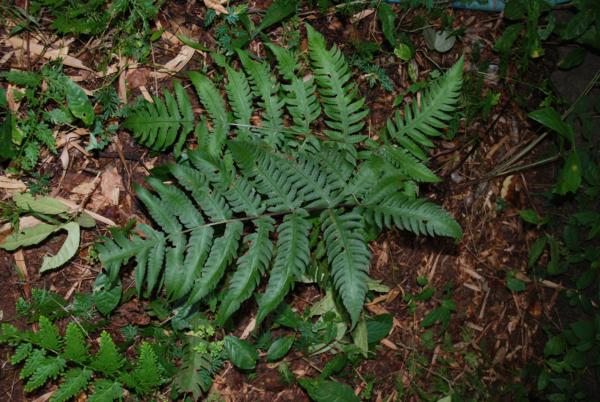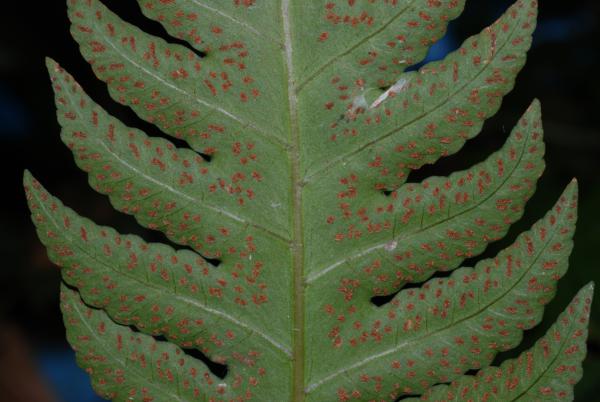
Pleocnemia irregularis (C.Presl) Holttum
Family
Tectariaceae
Nomenclature
Pleocnemia irregularis (C.Presl) Holttum, Kew Bull. 29: 347. 1974; Tagawa & K.Iwats., Fl. Thailand 3: 387. 1988; Holttum, Fl. Males., Ser. II, Pterid. 2: 12. 1991; Boonkerd & Pollawatn, Pterid. Thailand: 160, 207. 2000. – Polypodium irregulare C.Presl, Rel. Haenk. 1: 21. 1825. – Tectaria irregularis (C.Presl) Copel., Philipp. J. Sci., Sect. C, Botany 2: 416. 1907. – Arcypteris irregularis (C.Presl) Holttum, Reinwardtia 1: 193, f. 1–3.1951; Holttum, Rev. Fl. Malaya ed. 1, 2: 538, f. 317 & 318. 1955 [‘1954’]; Holttum, Dansk Bot. Ark. 20: 31. 1961; Tagawa & K.Iwats., SouthE. Asian Stud. 3(3): 86. 1965; Tagawa & K.Iwats., SouthE. Asian Stud. 5: 101. 1967; Tagawa & K.Iwats., Acta Phytotax. Geobot. 23: 56. 1968. – Type: Haenke s.n., Philippines (wrongly stated to be from Mexico).
Tectaria cumingiana auct. non (Hook.) C.Chr.: Tardieu & C.Chr., Notul. Syst. (Paris) 7: 96. 1938; Tardieu & C.Chr., Fl. Indo-Chine 7(2): 412. 1941.
Description
Rhizome thick, suberect, short, densely scaly; scales linear, up to 30 by 2 mm, dark brown, thin and more or less crisped, entire or irregularly toothed at margin. Stipes up to 80 cm long, dark and scaly at base, stramineous upwards. Laminae bipinnatifid to bipinnate at base, oblong-subdeltoid, usually more than 1 m long, 70 cm wide at base; basal pinnae the largest, asymmetrically subdeltoid with large basiscopic pinnules, basiscopic pinnules lobed to halfway, middle pinnae oblong-lanceolate, acute to acuminate at apex, shortly stalked, with several, free pinnules, apical portion large, pinnatifid; rachis and pinna-rachis glabrescent; pinnules sessile or more or less adnate, oblong-subdeltoid, falcate, caudate at apex, cuneate at base, waved at margin, usually about 10 by 1.7 cm; chartaceous, green to yellow-green, brownish in dried specimens, glandular hairy at margin and on lower surface; veins forming copious anastomosis, a distinct broad tooth at each sinus between pinnules and between crenae of pinnules. Sori small, dorsal on anastomosing veins, scattered irregularly; exindusiate .
Distribution in Thailand
NORTHERN: Chiang Mai, Phitsanulok; SOUTH-WESTERN: Kanchanaburi, Phetchaburi; CENTRAL: Nakhon Nayok; SOUTH-EASTERN: Chon Buri, Chanthaburi, Trat; PENINSULAR: Chumphon, Ranong, Surat Thani, Phangnga, Phuket, Nakhon Si Thammarat, Trang, Satun, Pattani, Yala, Narathiwat.
Distribution in Cambodia
Kampot, Koh Kong.
Wider Distribution
Burma (Tenasserim), Cambodia, throughout Malesia to Fiji.
Ecology
On rather dry slopes in dense forests at low or medium altitudes.
Proposed IUCN Conservation Assessment
Least Concern (LC). This species is widespread and not under any known threat.
Voucher specimens - Thailand
Middleton et al. 4331, Surat Thani, Khlong Phanom National Park (E); Middleton et al. 4411, Nakhon Si Thammarat, Namtok Yong National Park (E).
Voucher specimens - Cambodia
Viboth R6-2, Koh Kong, Thma Baing (P).
Habit
Lower surface of lamina with sori
Site hosted by the Royal Botanic Garden Edinburgh. Content managed by Stuart Lindsay, Gardens by the Bay, Singapore and David Middleton, Singapore Botanic Gardens. Last updated 24 January 2012

